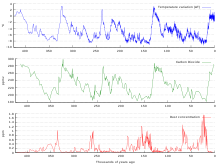Orbital forcing
Orbital forcing is the effect on climate of slow changes in the tilt of the Earth's axis and shape of the orbit (see Milankovitch cycles). These orbital changes change the total amount of sunlight reaching the Earth by up to 25% at mid-latitudes (from 400 to 500 Wm−2 at latitudes of 60 degrees). In this context, the term "forcing" signifies a physical process that affects the Earth's climate.
This mechanism is believed to be responsible for the timing of the ice age cycles. A strict application of the Milankovitch theory does not allow the prediction of a "sudden" ice age (rapid being anything under a century or two), since the fastest orbital period is about 20,000 years. The timing of past glacial periods coincides very well with the predictions of the Milankovitch theory, and these effects can be calculated into the future.
Overview

It is sometimes asserted that the length of the current interglacial temperature peak will be similar to the length of the preceding interglacial peak (Sangamonian/Eem Stage), and that therefore we might be nearing the end of this warm period. However, this conclusion is probably mistaken: the lengths of previous interglacials were not particularly regular (see graphic at right). Berger and Loutre (2002) argue that “with or without human perturbations, the current warm climate may last another 50,000 years. The reason is a minimum in the eccentricity of Earth's orbit around the Sun.”[1] Also, Archer and Ganopolski (2005) report that probable future CO2 emissions may be enough to suppress the glacial cycle for the next 500 kyr.[2]
Note in the graphic the strong 100,000 year periodicity of the cycles, and the striking asymmetry of the curves. This asymmetry is believed to result from complex interactions of feedback mechanisms. It has been observed that ice ages deepen by progressive steps, but the recovery to interglacial conditions occurs in one big step.
Orbital mechanics require that the length of the seasons be proportional to the swept areas of the seasonal quadrants, so when the eccentricity is extreme, the seasons on the far side of the orbit can last substantially longer. Today, when autumn and winter in the Northern Hemisphere occur at closest approach, the Earth is moving at its maximum velocity and therefore autumn and winter are slightly shorter than spring and summer.

Today, Northern Hemisphere summer is 4.66 days longer than winter and spring is 2.9 days longer than autumn.[3] As axial precession changes the place in the Earth's orbit where the solstices and equinoxes occur, Northern Hemisphere winters will get longer and summers will get shorter, eventually creating conditions believed to be favorable for triggering the next glacial period.
The arrangements of land masses on the Earth's surface are believed to reinforce the orbital forcing effects. Comparisons of plate tectonic continent reconstructions and paleoclimatic studies show that the Milankovitch cycles have the greatest effect during geologic eras when landmasses have been concentrated in polar regions, as is the case today. Greenland, Antarctica, and the northern portions of Europe, Asia, and North America are situated such that a minor change in solar energy will tip the balance in the climate of the Arctic, between year-round snow/ice preservation and complete summer melting. The presence or absence of snow and ice is a well-understood positive feedback mechanism for climate.
References
- ^ Berger, A.; Loutre, M. F. (23 August 2002). "An Exceptionally Long Interglacial Ahead?". Science. 297 (5585): 1287–1288. doi:10.1126/science.1076120. PMID 12193773.
- ^ Archer, David; Ganopolski, Andrey (5 May 2005). "A Movable Trigger: Fossil Fuel CO2 And The Onset Of The Next Glaciation". Geochemistry, Geophysics, Geosystems. 6 (5): Q05003. doi:10.1029/2004GC000891.
- ^ Benson, Gregory (11 December 2007). "Global Warming, Ice Ages, and Sea Level Changes: Something new or an astronomical phenomenon occurring in present day?".
{{cite web}}: Cite has empty unknown parameter:|dead-url=(help)
Further reading
- Hays, J. D.; Imbrie, John; Shackleton, N. J. (1976). "Variations in the Earth's Orbit: Pacemaker of the Ice Ages". Science. 194 (4270): 1121–1132. doi:10.1126/science.194.4270.1121. PMID 17790893.
- Hays, James D. (1996). Schneider, Stephen H. (ed.). Encyclopedia of Weather and Climate. New York: Oxford University Press. pp. 507–508. ISBN 0-19-509485-9.
{{cite encyclopedia}}: Missing or empty|title=(help) - Lutgens, Frederick K.; Tarbuck, Edward J. (1998). The Atmosphere. An Introduction to Meteorology. Upper Saddle River, N.J.: Prentice-Hall. ISBN 0-13-742974-6.
- National Research Council (1982). Solar Variability, Weather, and Climate. Washington, D.C.: National Academy Press. p. 7. ISBN 0-309-03284-9.
External links
- The NOAA page on Climate Forcing Data includes (calculated) data on orbital variations over the last 50 million years and for the coming 20 million years
- The orbital simulations by Varadi, Ghil and Runnegar (2003) provide another, slightly different series for orbital eccentricity
Further reading
- Cionco, Rodolfo G., and Pablo Abuin. "On planetary torque signals and sub-decadal frequencies in the discharges of large rivers." Advances in Space Research 57.6 (2016): 1411-1425.
